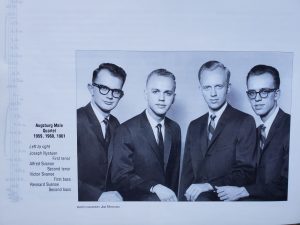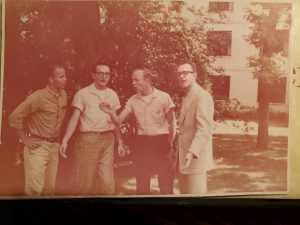
The full and melodic harmony reminiscent of male quartets that represented many Lutheran colleges in the first half of the 20th century will be on full display at the Silver Auggies lunch on Saturday, September 28, when the Augsburg Male Quartet from 1959 provides special music.
The luncheon music will feature Rennard Svanoe ’59, MDiv ’62; Victor Svanoe ’62; Jim Svanoe; and Donald Gilberg ‘60. Intended for Augsburg graduates from 1968 and earlier, the luncheon is one of many events scheduled for Augsburg’s Homecoming and Reunion Week, Sept. 24-28.
In the late 1800s, Augsburg was among the first Lutheran colleges to discover the value of these “singing ambassadors,” whose four-part a cappella harmony and spiritual messages inspired many in congregations, youth conventions, and a variety of other venues. Augsburg’s history of male quartets (1885-1961) has been documented in the 2004 book, The Augsburg Quartets: A Mission-Driven Tradition, written by David M. Larson and Merton Strommen ’42. The book includes pictures of most of the Augsburg quartets, whose early participants included F. Melius Christiansen, whose distinctive mark on Lutheran a cappella choir music is indelible.
Of the three Svanoe brothers who sang with Gilberg in the 1958 quartet—Alfred, Rennard, and Victor, two will sing at the luncheon. Alfred has passed away, and his cousin, Jim Svanoe, a Luther College graduate, will fill his role on Sept. 28. Joe Nystuen MDiv ’62, who sang with the 1959 (touring) quartet, is living with one lung, and so Gilberg will take his part.
Starting Early
Growing up in a “singing family,” the three Svanoe brothers got a good head start in the art of harmonizing by performing at family gatherings, where they would sing three-part treble harmony—before their voices changed. In their high school years, their uncle Dick Svanoe sat at the piano and added his barbershop-trained voice, thus providing the fourth part.
 At college, singing in the Augsburg Choir put the Svanoe brothers in touch with Don Gilberg (from Carpio, North Dakota)—a connection that led to formation of the quartet, and eventually to an audition with Augsburg’s Leland B. Sateren in order to enable them to officially represent the College as the Augsburg Male Quartet.
At college, singing in the Augsburg Choir put the Svanoe brothers in touch with Don Gilberg (from Carpio, North Dakota)—a connection that led to formation of the quartet, and eventually to an audition with Augsburg’s Leland B. Sateren in order to enable them to officially represent the College as the Augsburg Male Quartet.
Often, the quartet sang at the Svanoes’ home church, Oak Grove Lutheran in nearby Richfield, Minnesota, where Merton Strommen (a member of an earlier Augsburg quartet) had served as the brothers’ high school Sunday School teacher, and as youth choir director. The relationship with Strommen led to the quartet’s opportunity in summer 1958 to sing in Green Lake, Wisc., at the convention of the Luther League Federation, for which Strommen served as director.
A year later, after worship one Sunday, the quartet gathered in the sanctuary where another Oak Grove member, Norman Kaupang, set up his equipment to record the quartet’s songs for a 33-RPM record, which was later remastered for the CD that now appears if you Google “Augsburg Male Quartet.” By then, Joe Nystuen had replaced Gilberg in the group, adding an inspirational verbal component between musical sets at each concert.
Touring
Of his experience touring with the quartet, Rennard Svanoe says his Midwestern horizons were “considerably broadened.” Their travels allowed the quartet to meet nearly all the pastors of the Lutheran Free Church (a predecessor body of the ELCA), and to explore a variety of really interesting places—the Rocky Mountains, Puget Sound, the Columbia River, Norwegian fjords, and the English Channel. Their experiences even included a visit to Svanoe Island, the brothers’ ancestral home on the west coast of Norway.
The quartet appeared at homecoming events at Augsburg (even after graduating), and at various congregations in the Twin Cities area. At one concert, traveling Lutheran evangelist Oscar Hanson heard the quartet sing and was so impressed that he offered to arrange for a tour of Norway in 1961. Hanson (late father of ELCA Presiding Bishop Emeritus Mark Hanson) had served as pastor of a church in Oslo, Norway, and had enough connections to set up a tour that included 55 appearances in the U.S., followed by 25 appearances in Norway.
Most of the group’s concerts in Norway were held in state Lutheran churches, and three in cathedrals. They found their largest crowd in a hall in Bergen, where they filled the facility. That concert holds a special memory for Rennard Svanoe as he recalls one young man climbing onto an open window sill seeking a better view of the quartet, only to land on the ground outside—unharmed, thankfully.
In the Long Term
One notable offshoot of the quartets’ success over the years has been the coming together, since 1993, of numerous former quartet members, to unite in song by participating in the Augsburg Centennial Singers, an all-male choir organized by Strommen, and for some years, directed by him. The group of about 50 continues to perform, and membership has been expanded beyond the former quartets.
Such opportunities can build memories for a lifetime—not to mention long-term friendships. Musical groups tend to have powerful potential to do so. Rennard Svanoe says that singing in the quartet with brothers and a best friend “built in a long-term effect, as we often referred to our experiences over the years.”
When asked if any particular quartet experience stands out as something to truly relish, Rennard Svanoe described a Sunday afternoon concert in Abercrombie, North Dakota, in 1959. As an electrical storm brewed during the first set, the quartet was singing the classical number, “Creation.” As they sang about darkness covering the face of the deep, the lights in the sanctuary went out. Nonetheless, they continued singing—memorization does pay off! The piece continued with words about the Spirit moving over the face of the waters in a prolonged passage that ended with the quartet singing in unison, “And God said, ‘Let there be light,’ and there was light, light, and there was LIGHT.” At that moment the lights came back on in perfect timing with the song.
As the saying goes, God has a sense of humor—and certainly delights in music. The sense of timing on that blessing was absolutely perfect to the Quartet.
—by Cheryl Crockett ’89
